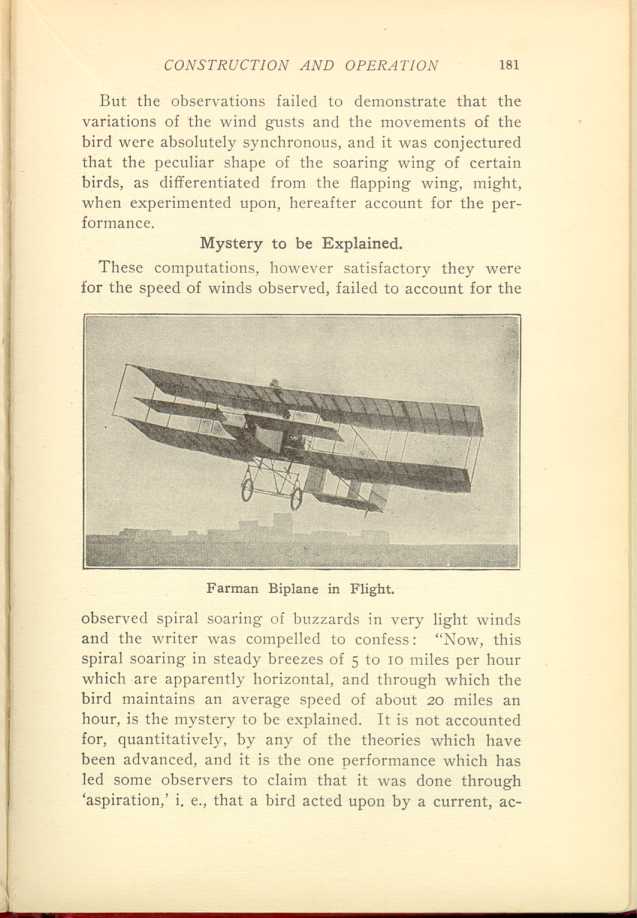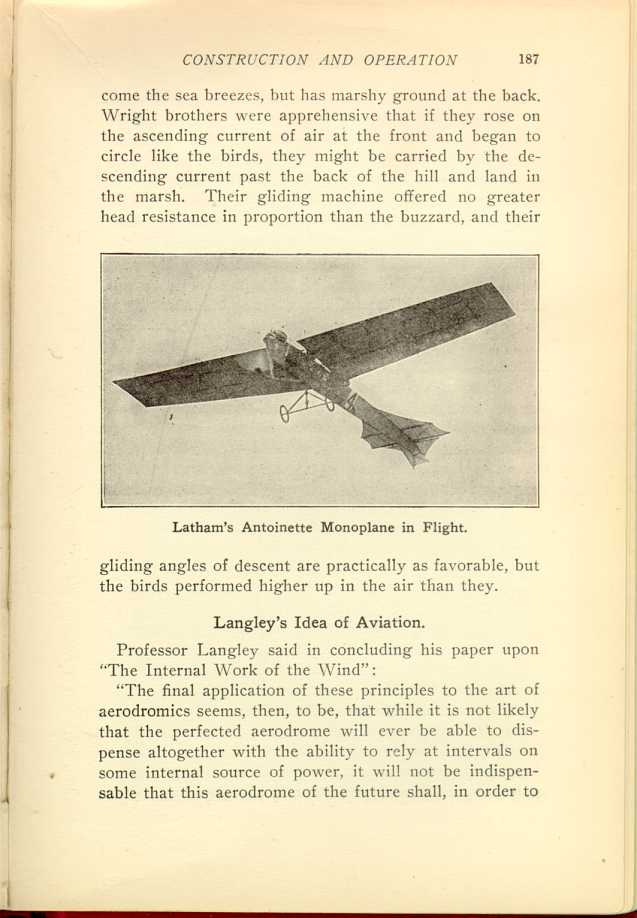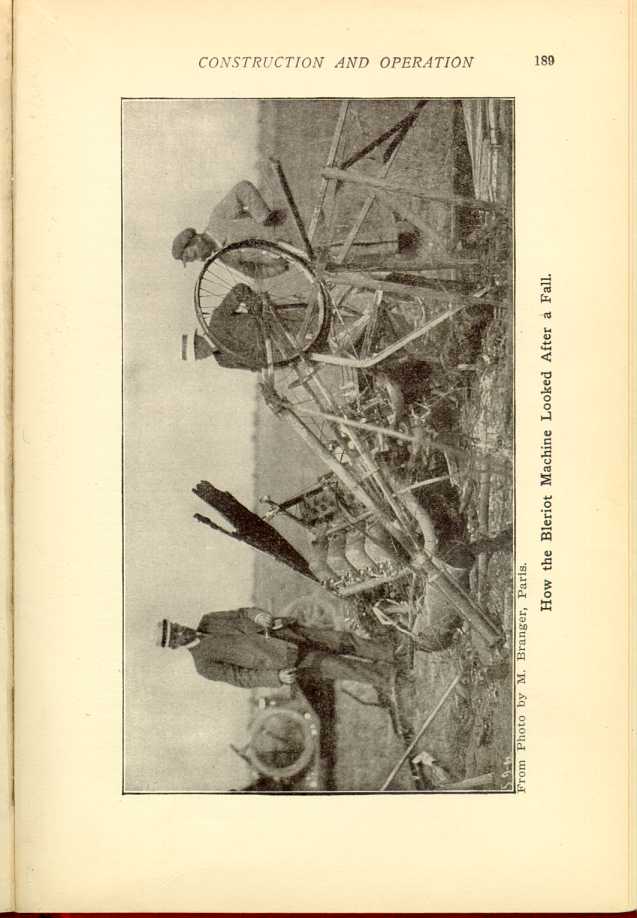20. CHAPTER XX.
SOARING FLIGHT.
By Octave Chanute.
[1]There is a wonderful performance daily exhibited in southern climes and occasionally seen in northerly latitudes in summer, which has never been thoroughly explained. It is the soaring or sailing flight of certain varieties of large birds who transport themselves on rigid, unflapping wings in any desired direction; who in winds of 6 to 20 miles per hour, circle, rise, advance, return and remain aloft for hours without a beat of wing, save for getting under way or convenience in various maneuvers. They appear to obtain from the wind alone all the necessary energy, even to advancing dead against that wind. This feat is so much opposed to our general ideas of physics that those who have not seen it sometimes deny its actuality, and those who have only occasionally witnessed it subsequently doubt the evidence of their own eyes. Others, who have seen the exceptional performances, speculate on various explanations, but the majority give it up as a sort of "negative gravity."
Soaring Power of Birds.
The writer of this paper published in the "Aeronautical Annual" for 1896 and 1897 an article upon the sailing flight of birds, in which he gave a list of the authors who
Great Power of Gulls.
It was shown that the same bird in flapping flight in calm air, with an attitude or incidence of 3 degrees to 5 degrees above the horizon and a speed of 20.4 miles an hour was well sustained and expended 5.88 foot-pounds per second, this being at the rate of 204 pounds sustained per horsepower. It was stated also that a gull in its observed maneuvers, rising up from a pile head on unflapping wings, then plunging forward against the wind and subsequently rising higher than his starting point, must either time his ascents and descents exactly with the variations in wind velocities, or must meet a wind billow rotating on a horizontal axis and come to a poise on its crest, thus availing of an ascending trend.
But the observations failed to demonstrate that the variations of the wind gusts and the movements of the bird were absolutely synchronous, and it was conjectured that the peculiar shape of the soaring wing of certain birds, as differentiated from the flapping wing, might, when experimented upon, hereafter account for the performance.
Mystery to be Explained.
These computations, however satisfactory they were
for the speed of winds observed, failed to account for the

Farman Biplane in Flight.
[Description: Black and white photograph: Biplane in flight.]
Buzzards Soar in Dead Calm.
A still greater mystery was propounded by the few observers who asserted that they had seen buzzards soaring in a dead calm, maintaining their elevation and their speed. Among these observers was Mr. E. C. Huffaker, at one time assistant experimenter for Professor Langley. The writer believed and said then that he must in some way have been mistaken, yet, to satisfy himself, he paid several visits to Mr. Huffaker, in Eastern Tennessee and took along his anemometer. He saw quite a number of buzzards sailing at a height of 75 to 100 feet in breezes measuring 5 or 6 miles an hour at the surface of the ground, and once he saw one buzzard soaring apparently in a dead calm.
The writer was fairly baffled. The bird was not simply gliding, utilizing gravity or acquired momentum, he was actually circling horizontally in defiance of physics and mathematics. It took two years and a whole series of further observations to bring those two sciences into accord with the facts.
Results of Close Observations.
Curiously enough the key to the performance of circling in a light wind or a dead calm was not found through the usual way of gathering human knowledge, i. e., through observations and experiment. These had failed because I did not know what to look for. The mystery was, in fact, solved by an eclectic process of conjecture and computation, but once these computations indicated what observations should be made, the results gave at once the reasons for the circling of the birds, for their then observed attitude, and for the necessity of an
These observations disclosed several facts:
1st.—That winds blowing five to seventeen miles per hour frequently had rising trends of 10 degrees to 15 degrees, and that upon occasions when there seemed to be absolutely no wind, there was often nevertheless a local rising of the air estimated at a rate of four to eight miles or more per hour. This was ascertained by watching thistledown, and rising fogs alongside of trees or hills of known height. Everyone will readily realize that when walking at the rate of four to eight miles an hour in a dead calm the "relative wind" is quite inappreciable to the senses and that such a rising air would not be noticed.
2nd.—That the buzzard, sailing in an apparently dead horizontal calm, progressed at speeds of fifteen to eighteen miles per hour, as measured by his shadow on the ground. It was thought that the air was then possibly rising 8.8 feet per second, or six miles per hour.
3rd.—That when soaring in very light winds the angle of incidence of the buzzards was negative to the horizon—i. e., that when seen coming toward the eye, the afternoon light shone on the back instead of on the breast, as would have been the case had the angle been inclined above the horizon.
4th.—That the sailing performance only occurred after the bird had acquired an initial velocity of at least fifteen or eighteen miles per hour, either by industrious flapping or by descending from a perch.
An Interesting Experiment.
5th.—That the whole resistance of a stuffed buzzard, at a negative angle of 3 degrees in a current of air of 15.52 miles per hour, was 0.27 pounds. This test was
This particular buzzard weighed in life 4.25 pounds, the area of his wings and body was 4.57 square feet, the maximum cross-section of his body was 0.110 square feet, and that of his wing edges when fully extended was 0.244 square feet.
With these data, it became surprisingly easy to compute the performance with the coefficients of Lilienthal for various angles of incidence and to demonstrate how this buzzard could soar horizontally in a dead horizontal calm, provided that it was not a vertical calm, and that the air was rising at the rate of four or six miles per hour, the lowest observed, and quite inappreciable without actual measuring.
Some Data on Bird Power.
The most difficult case is purposely selected. For if
we assume that the bird has previously acquired an initial
minimum speed of seventeen miles an hour (24.93
feet per second, nearly the lowest measured), and that
the air was rising vertically six miles an hour (8.80 feet
per second), then we have as the trend of the "relative
wind" encountered:
6/17 = 0.353, or the tangent of 19° 26'.
which brings the case into the category of rising wind
effects. But the bird was observed to have a negative
angle to the horizon of about 3°, as near as could be
guessed, so that his angle of incidence to the "relative
wind" was reduced to 16° 26'.
The relative speed of his soaring was therefore:
Velocity = [square root] 172 + 62 = 18.03 miles per hour.
At this speed, using the Langley co-efficient recently practically confirmed by the accurate experiments of Mr. Eiffel, the air pressure would be:
18.032 X 0.00327 = 1.063 pounds per square foot.
If we apply Lilienthal's co-efficients for an angle of 6° 26', we have for the force in action:
Normal: 4.57 X 1.063 X 0.912 = 4.42 pounds.
Tangential: 4.57 X 1.063 X 0.074 = -0.359 pounds, which latter, being negative, is a propelling force.
Results Astonish Scientists.
Thus we have a bird weighing 4.25 pounds not only thoroughly supported, but impelled forward by a force of 0.359 pounds, at seventeen miles per hour, while the experiments of Professor A. F. Zahm showed that the resistance at 15.52 miles per hour was only 0.27 pounds, or 0.27 X 172/15.522 = 0.324 pounds, at seventeen miles an hour.
These are astonishing results from the data obtained, and they lead to the inquiry whether the energy of the rising air is sufficient to make up the losses which occur by reason of the resistance and friction of the bird's body and wings, which, being rounded, do not encounter air pressures in proportion to their maximum cross-section.
We have no accurate data upon the co-efficients to apply and estimates made by myself proved to be much smaller than the 0.27 pounds resistance measured by Professor Zahm, so that we will figure with the latter as modified. As the speed is seventeen miles per hour, or 24.93 feet per second, we have for the work:
Work done, 0.324 X 24.93 = 8.07 foot pounds per second.
Endorsed by Prof. Marvin.
Corresponding energy of rising air is not sufficient at four miles per hour. This amounts to but 2.10 foot pounds per second, but if we assume that the air was rising at the rate of seven miles per hour (10.26 feet per second), at which the pressure with the Langley coefficient would be 0.16 pounds per square foot, we have on 4.57 square feet for energy of rising air: 4.57 X 0.16 X 10.26 = 7.50 foot pounds per second, which is seen to be still a little too small, but well within the limits of error, in view of the hollow shape of the bird's wings, which receive greater pressure than the flat planes experimented upon by Langley.
These computations were chiefly made in January, 1899, and were communicated to a few friends, who found no fallacy in them, but thought that few aviators would understand them if published. They were then submitted to Professor C. F. Marvin of the Weather Bureau, who is well known as a skillful physicist and mathematician. He wrote that they were, theoretically, entirely sound and quantitatively, probably, as accurate as the present state of the measurements of wind pressures permitted. The writer determined, however, to withhold publication until the feat of soaring flight had been performed by man, partly because he believed that, to ensure safety, it would be necessary that the machine should be equipped with a motor in order to supplement any deficiency in wind force.
Conditions Unfavorable for Wrights.
The feat would have been attempted in 1902 by Wright brothers if the local circumstances had been more favorable. They were experimenting on "Kill Devil Hill," near Kitty Hawk, N. C. This sand hill, about 100 feet high, is bordered by a smooth beach on the side whence

Latham's Antoinette Monoplane in Flight.
[Description: Black and white photograph: Monoplane in flight.]Langley's Idea of Aviation.
Professor Langley said in concluding his paper upon "The Internal Work of the Wind":
"The final application of these principles to the art of aerodromics seems, then, to be, that while it is not likely that the perfected aerodrome will ever be able to dispense altogether with the ability to rely at intervals on some internal source of power, it will not be indispensable that this aerodrome of the future shall, in order to
Now that dynamic flying machines have been evolved and are being brought under control, it seems to be worth while to make these computations and the succeeding explanations known, so that some bold man will attempt the feat of soaring like a bird. The theory underlying the performance in a rising wind is not new, it has been suggested by Penaud and others, but it has attracted little attention because the exact data and the maneuvers required were not known and the feat had not yet been performed by a man. The puzzle has always been to account for the observed act in very light winds, and it is hoped that by the present selection of the most difficult case to explain—i. e., the soaring in a dead horizontal calm—somebody will attempt the exploit.
Requisites for Soaring Flights.
The following are deemed to be the requisites and maneuvers to master the secrets of soaring flight:
1st—Develop a dynamic flying machine weighing about one pound per square foot of area, with stable equilibrium and under perfect control, capable of gliding by gravity at angles of one in ten (5 3/4°) in still air.
2nd.—Select locations where soaring birds abound and occasions where rising trends of gentle winds are frequent and to be relied on.
3rd.—Obtain an initial velocity of at least 25 feet per second before attempting to soar.
4th.—So locate the center of gravity that the apparatus shall assume a negative angle, fore and aft, of about 3°.

From Photo by M. Branger, Paris
How the Bleriot Machine Looked After a Fall.
[Description: Black and white illustration: Three men stand around wrecked
aeroplane.]
5th.—Circle like the bird. Simultaneously with the steering, incline the apparatus to the side toward which it is desired to turn, so that the centrifugal force shall be balanced by the centripetal force. The amount of the required inclination depends upon the speed and on the radius of the circle swept over.
6th.—Rise spirally like the bird. Steer with the horizontal rudder, so as to descend slightly when going with the wind and to ascend when going against the wind. The bird circles over one spot because the rising trends of wind are generally confined to small areas or local chimneys, as pointed out by Sir H. Maxim and others.
7th.—Once altitude is gained, progress may be made in any direction by gliding downward by gravity.
The bird's flying apparatus and skill are as yet infinitely superior to those of man, but there are indications that within a few years the latter may evolve more accurately proportioned apparatus and obtain absolute control over it.
It is hoped, therefore, that if there be found no radical error in the above computations, they will carry the conviction that soaring flight is not inaccessible to man, as it promises great economies of motive power in favorable localities of rising winds.
The writer will be grateful to experts who may point out any mistake committed in data or calculations, and will furnish additional information to any aviator who may wish to attempt the feat of soaring.